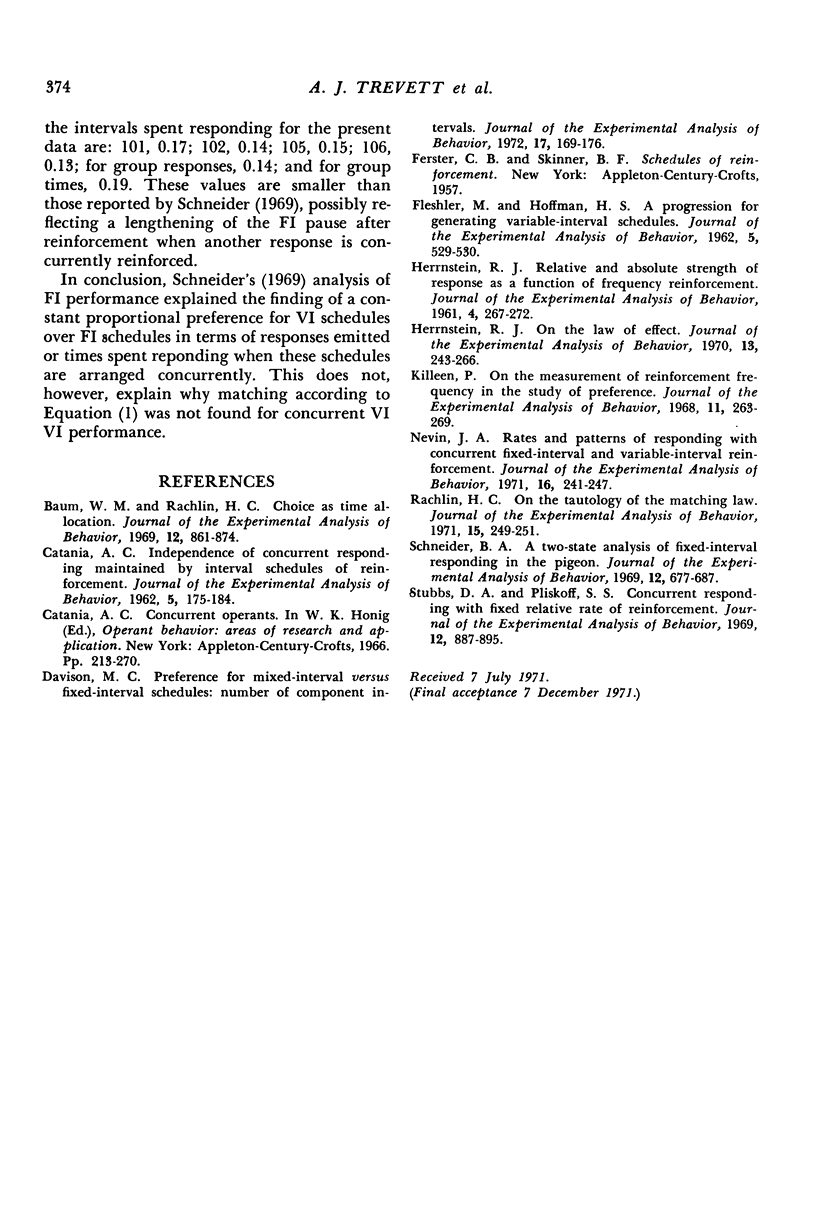Abstract
Four pigeons were trained under concurrent variable-interval variable-interval and fixed-interval variable-interval schedules in a two-key situation. Both response allocation and time allocation to the two schedules were measured when various reinforcement rates were arranged on each key. All animals showed an approximately constant proportional preference for the variable-interval schedule over the fixed-interval schedule. These results support Schneider's (1969) analysis of fixed-interval schedule performance.
Full text
PDF





Selected References
These references are in PubMed. This may not be the complete list of references from this article.
- Baum W. M., Rachlin H. C. Choice as time allocation. J Exp Anal Behav. 1969 Nov;12(6):861–874. doi: 10.1901/jeab.1969.12-861. [DOI] [PMC free article] [PubMed] [Google Scholar]
- CATANIA A. C. Independence of concurrent responding maintained by interval schedules of reinforcement. J Exp Anal Behav. 1962 Apr;5:175–184. doi: 10.1901/jeab.1962.5-175. [DOI] [PMC free article] [PubMed] [Google Scholar]
- Davison M. C. Preference for mixed-interval versus fixed-interval schedules: number of component intervals. J Exp Anal Behav. 1972 Mar;17(2):169–176. doi: 10.1901/jeab.1972.17-169. [DOI] [PMC free article] [PubMed] [Google Scholar]
- FLESHLER M., HOFFMAN H. S. A progression for generating variable-interval schedules. J Exp Anal Behav. 1962 Oct;5:529–530. doi: 10.1901/jeab.1962.5-529. [DOI] [PMC free article] [PubMed] [Google Scholar]
- HERRNSTEIN R. J. Relative and absolute strength of response as a function of frequency of reinforcement. J Exp Anal Behav. 1961 Jul;4:267–272. doi: 10.1901/jeab.1961.4-267. [DOI] [PMC free article] [PubMed] [Google Scholar]
- Herrnstein R. J. On the law of effect. J Exp Anal Behav. 1970 Mar;13(2):243–266. doi: 10.1901/jeab.1970.13-243. [DOI] [PMC free article] [PubMed] [Google Scholar]
- Killeen P. On the measurement of reinforcement frequency in the study of preference. J Exp Anal Behav. 1968 May;11(3):263–269. doi: 10.1901/jeab.1968.11-263. [DOI] [PMC free article] [PubMed] [Google Scholar]
- Nevin J. A. Rates and patterns of responding with concurrent fixed-interval and variable-interval reinforcement. J Exp Anal Behav. 1971 Sep;16(2):241–247. doi: 10.1901/jeab.1971.16-241. [DOI] [PMC free article] [PubMed] [Google Scholar]
- Rachlin H. On the tautology of the matching law. J Exp Anal Behav. 1971 Mar;15(2):249–251. doi: 10.1901/jeab.1971.15-249. [DOI] [PMC free article] [PubMed] [Google Scholar]
- Schneider B. A. A two-state analysis of fixed-interval responding in the pigeon. J Exp Anal Behav. 1969 Sep;12(5):677–687. doi: 10.1901/jeab.1969.12-677. [DOI] [PMC free article] [PubMed] [Google Scholar]
- Stubbs D. A., Pliskoff S. S. Concurrent responding with fixed relative rate of reinforcement. J Exp Anal Behav. 1969 Nov;12(6):887–895. doi: 10.1901/jeab.1969.12-887. [DOI] [PMC free article] [PubMed] [Google Scholar]


